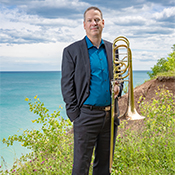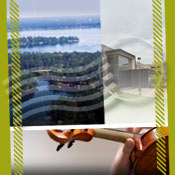
MSO Operations Team Prepares for Alpine Symphony
David Lewellen
PUBLISHED
Tagged Under: 2022.23 Season, Bradley Symphony Center
The Bradley Symphony Center has never seen anything like the Alpine Symphony.
The Milwaukee Symphony will open its second full season on Wisconsin Avenue September 30 and October 1 with Richard Strauss’s massive tone poem, scored for a huge orchestra that will fill the stage to its limit.
Starting off the season with an enormous piece is “a great idea for the audience,” Françoise Moquin, director of orchestra personnel, said wryly. “People love it, the hall is full, the energy level is really high.” But it takes an enormous amount of work behind the scenes to make it happen.
“This will be the largest orchestra we’ve put onstage in Allen-Bradley Hall,” said Terrell Pierce, director of operations. “We’re running out of firsts in the new hall – which is a good thing.”
The piece was originally planned for the 2020.21 season that was cancelled because of the pandemic, but the symphony rescheduled it to open this season with a splash – and in hopes of celebrating the continuing ebb of COVID, said Bret Dorhout, the MSO’s vice president of artistic planning.
The season’s other piece requiring extra-large forces will be Mahler’s Symphony No. 2, which will close the year. “We can do two or three big projects a year without short-changing the rest of the programs,” Dorhout said. The symphony’s management deliberately chose to put the Mahler, which requires a chorus, at the end of the season to accommodate the choral rehearsal schedule.
The MSO last did Alpine Symphony in October 1998 in Uihlein Hall with former music director Andreas Delfs conducting, and Dorhout said that every 20 years or so is about right for a piece that requires so many players.
For Moquin, that means hiring lots of extra musicians for one week, to make up the difference between the MSO’s full-time roster and the extravagant demands of Strauss’s score. The orchestra always maintains a list of extra and substitute musicians, and Moquin works with section principals to determine whom to call in what order.
The horn section, however, is a whole different proposition. Usually the MSO has five horns on the full-time roster. Strauss’s score asks for 20, and the normal sub list does not go 15 deep. “Being near Chicago is nice,” she said, “because that’s another talent pool an hour and a half away.”
Strauss requested eight horns onstage plus an offstage ensemble of 12 more. But Dorhout has programmed the piece before with other orchestras, “and we’ve never hired 20,” he said. “That’s a bit of overkill.” The MSO will use eight offstage horns, and five of that number will also come out and play the full onstage score after their featured passage. Something similar will happen in the trumpet section.
“Even if we had done it only five years ago, we wouldn’t have a clue” about logistics in the new space, Moquin said. “Concerts like this, I’m glad I only have to manage personnel. We’ve been talking in production meetings about offstage placement, monitors, and where the musicians can put their cases.”
Details such as those are Pierce’s job. During rehearsals, he said, the orchestra, and Music Director Ken-David Masur will experiment with using a video monitor and a second conductor for the offstage ensemble, and which doors to open at which angle for the best sound. The piece calls for a pipe organ, which the Bradley Center does not yet have, but a three-manual electronic organ will be stationed offstage, with speakers in the space reserved for an organ loft.
Pierce is also responsible for renting instruments that the orchestra doesn’t own, such as a bass oboe. The MSO does have its own set of Wagner tubas (an uncommon instrument that horn players double on), but for this concert, Pierce “had to find special mutes for the Wagner tubas. I didn’t know they had mutes.” The MSO also owns a wind machine, but another item on Pierce’s to-do list in mid-September was making sure that it would be suitable for this particular piece.
Finding space in the wings for performers (to say nothing of their instrument cases) “will be a stretch,” Pierce said. “We’re also going to have the organ backstage, and two Steinways.” The first half of the concert also includes Mendelssohn’s Concerto for Two Pianos, which means that the space crunch is “a problem Ken and I created,” Dorhout joked.
Onstage, Pierce has to plan space for two harps, two sets of timpani, the wind machine, a thunder sheet, extra brass and woodwind players, and also extras in every string section to balance the sound.
But the learning experience “will definitely inform a lot of decisions later on,” he said. “It can be intimidating, but I think the orchestra will be thrilled to start with it.”



